Armenia and WB discuss possible new cooperation programs
14.02.2025,
14:16
Armenian Deputy Prime Minister Mher Grigoryan and World Bank Director for the Caucasus Region Roland Pryce discussed directions of possible new cooperation programs in Yerevan, the government press service reports.

YEREVAN, February 14. /ARKA/. Armenian Deputy Prime Minister Mher Grigoryan and World Bank Director for the Caucasus Region Roland Pryce discussed directions of possible new cooperation programs in Yerevan, the government press service reports.
The sides exchanged views on the reforms in public administration, touching upon, in particular, the development of a new methodology of strategic management and implementation of the digital agenda.
The sides attached importance of the new Partnership Framework Program with Armenia for 2025-2029 approved by the WB Board.
About the Partnership Framework Program with Armenia
The World Bank Group’s Board of Executive Directors on January 21, 2025, endorsed a new five-year Country Partnership Framework (CPF) for Armenia.
The framework aims to reduce poverty and promote prosperity across the country by creating better job opportunities, improving human capital outcomes, and enhancing resilience.
The new strategy emphasizes mobilizing private capital through close collaboration across the World Bank Group’s institutions: the International Bank for Reconstruction and Development (IBRD), the International Finance Corporation (IFC), and the Multilateral Investment Guarantee Agency (MIGA). IBRD expects to fund around $1 billion over the next five years to promote reforms that would allow IFC and MIGA to attract more private capital.
IFC, with its focus on the private sector, plans to boost investments in infrastructure and real sectors, including through public-private partnerships (PPPs). Under the CPF, IFC will aim to support the private sector’s contribution to sustainable infrastructure development, such as green energy, water, connectivity, and greener transport. IFC will also work with financial institutions to broaden the reach of climate-focused products, support sustainable finance, promote green bonds, and advance digital transformation. IFC’s investments are expected to range from $500 million to $700 million.
About World Bank programs in Armenia
Since 1992, the World Bank has provided around $3 billion, including a current portfolio of around $400 million in investment lending, grants, analytical work, and technical assistance, to Armenia from the International Bank for Reconstruction and Development (IBRD), trust funds, and the International Development Association (IDA), to which Armenia also became a donor in 2023. IFC has invested nearly $1.3 billion in Armenia, including mobilization, since it became a member country in 1995, and MIGA has investment nearly $39 million.
The sides exchanged views on the reforms in public administration, touching upon, in particular, the development of a new methodology of strategic management and implementation of the digital agenda.
The sides attached importance of the new Partnership Framework Program with Armenia for 2025-2029 approved by the WB Board.
About the Partnership Framework Program with Armenia
The World Bank Group’s Board of Executive Directors on January 21, 2025, endorsed a new five-year Country Partnership Framework (CPF) for Armenia.
The framework aims to reduce poverty and promote prosperity across the country by creating better job opportunities, improving human capital outcomes, and enhancing resilience.
The new strategy emphasizes mobilizing private capital through close collaboration across the World Bank Group’s institutions: the International Bank for Reconstruction and Development (IBRD), the International Finance Corporation (IFC), and the Multilateral Investment Guarantee Agency (MIGA). IBRD expects to fund around $1 billion over the next five years to promote reforms that would allow IFC and MIGA to attract more private capital.
IFC, with its focus on the private sector, plans to boost investments in infrastructure and real sectors, including through public-private partnerships (PPPs). Under the CPF, IFC will aim to support the private sector’s contribution to sustainable infrastructure development, such as green energy, water, connectivity, and greener transport. IFC will also work with financial institutions to broaden the reach of climate-focused products, support sustainable finance, promote green bonds, and advance digital transformation. IFC’s investments are expected to range from $500 million to $700 million.
About World Bank programs in Armenia
Since 1992, the World Bank has provided around $3 billion, including a current portfolio of around $400 million in investment lending, grants, analytical work, and technical assistance, to Armenia from the International Bank for Reconstruction and Development (IBRD), trust funds, and the International Development Association (IDA), to which Armenia also became a donor in 2023. IFC has invested nearly $1.3 billion in Armenia, including mobilization, since it became a member country in 1995, and MIGA has investment nearly $39 million.



